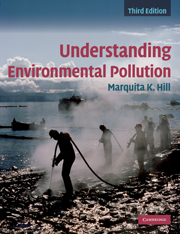Book contents
- Frontmatter
- Contents
- Preface
- Acknowledgements
- List of abbreviations and acronyms
- 1 Understanding pollution
- 2 Reducing risk, reducing pollution
- 3 Chemical toxicity
- 4 Chemical exposures and risk assessment
- 5 Air pollution
- 6 Acid deposition
- 7 Global climate change
- 8 Stratospheric ozone depletion
- 9 Water pollution
- 10 Drinking-water pollution
- 11 Solid waste
- 12 Hazardous waste
- 13 Energy
- 14 Persistent, bioaccumulative, and toxic
- 15 Metals
- 16 Pesticides
- 17 Pollution at home
- 18 Zero waste, zero emissions
- 19 Chemistry: some basic concepts
- Index
- References
3 - Chemical toxicity
Published online by Cambridge University Press: 05 June 2012
- Frontmatter
- Contents
- Preface
- Acknowledgements
- List of abbreviations and acronyms
- 1 Understanding pollution
- 2 Reducing risk, reducing pollution
- 3 Chemical toxicity
- 4 Chemical exposures and risk assessment
- 5 Air pollution
- 6 Acid deposition
- 7 Global climate change
- 8 Stratospheric ozone depletion
- 9 Water pollution
- 10 Drinking-water pollution
- 11 Solid waste
- 12 Hazardous waste
- 13 Energy
- 14 Persistent, bioaccumulative, and toxic
- 15 Metals
- 16 Pesticides
- 17 Pollution at home
- 18 Zero waste, zero emissions
- 19 Chemistry: some basic concepts
- Index
- References
Summary
For a better understanding of whether a pollutant may be harmful to living creatures, we need to understand some basic principles of toxicology. Section I introduces “the dose makes the poison,” acute and chronic toxicity, systemic and local effects, and how the body stores chemicals. We follow a chemical through the body via absorption, distribution, metabolism, and excretion. Section II examines factors affecting toxicity including gender, age, and poor nutrition and looks at how organs such as the liver, kidneys, and skin are affected by toxicants. Section III considers some of the greatest worries that people have regarding toxic substances – impacts on children and the fetus, and the ability of some chemicals to cause cancer. Environmental hormones, pollutants that mimic natural hormones, are also considered. The chapter also addresses topics such as bisphenol A, pesticides, and pollution's toll on health in China.
SECTION I
All substances are toxic
Paracelsus, a controversial sixteenth-century physician, was faulted for treating his patients with arsenic and mercury, substances known to be toxic. Paracelsus responded with a statement still repeated 500 years later. “All substances are poisons. There is none, which is not a poison. The right dose differentiates a poison and a remedy.” That is to say, a “non-toxic” substance can be toxic at a high enough dose, and a very toxic substance can be safe if the dose is low enough. “The dose makes the poison” is a convenient rule (Figure 3.1).
- Type
- Chapter
- Information
- Understanding Environmental Pollution , pp. 57 - 88Publisher: Cambridge University PressPrint publication year: 2010
References
- 1
- Cited by

